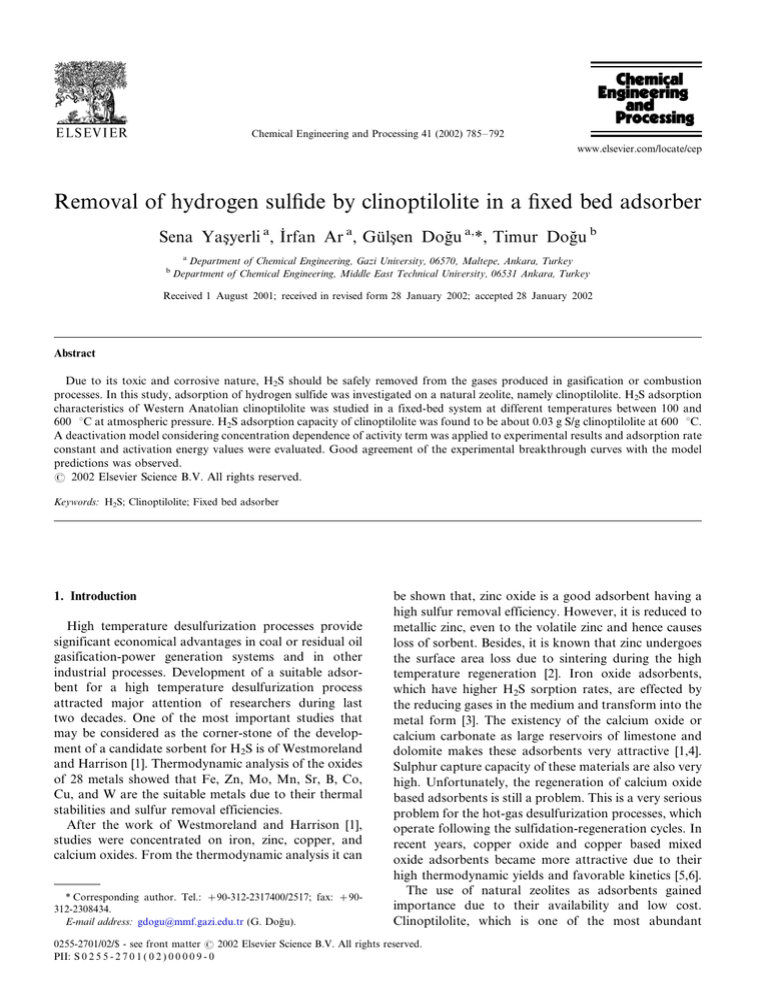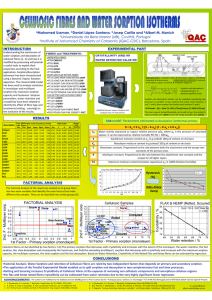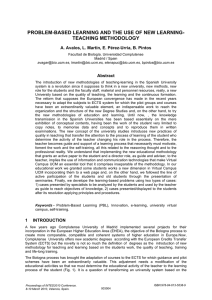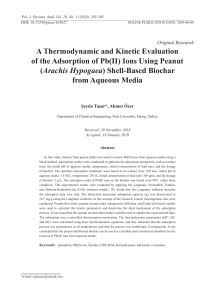Removal of hydrogen sulfide by clinoptilolite in a fixed bed adsorber
Anuncio

Chemical Engineering and Processing 41 (2002) 785 /792 www.elsevier.com/locate/cep Removal of hydrogen sulfide by clinoptilolite in a fixed bed adsorber Sena Yaşyerli a, İrfan Ar a, Gülşen Doğu a,*, Timur Doğu b a b Department of Chemical Engineering, Gazi University, 06570, Maltepe, Ankara, Turkey Department of Chemical Engineering, Middle East Technical University, 06531 Ankara, Turkey Received 1 August 2001; received in revised form 28 January 2002; accepted 28 January 2002 Abstract Due to its toxic and corrosive nature, H2S should be safely removed from the gases produced in gasification or combustion processes. In this study, adsorption of hydrogen sulfide was investigated on a natural zeolite, namely clinoptilolite. H2S adsorption characteristics of Western Anatolian clinoptilolite was studied in a fixed-bed system at different temperatures between 100 and 600 8C at atmospheric pressure. H2S adsorption capacity of clinoptilolite was found to be about 0.03 g S/g clinoptilolite at 600 8C. A deactivation model considering concentration dependence of activity term was applied to experimental results and adsorption rate constant and activation energy values were evaluated. Good agreement of the experimental breakthrough curves with the model predictions was observed. # 2002 Elsevier Science B.V. All rights reserved. Keywords: H2S; Clinoptilolite; Fixed bed adsorber 1. Introduction High temperature desulfurization processes provide significant economical advantages in coal or residual oil gasification-power generation systems and in other industrial processes. Development of a suitable adsorbent for a high temperature desulfurization process attracted major attention of researchers during last two decades. One of the most important studies that may be considered as the corner-stone of the development of a candidate sorbent for H2S is of Westmoreland and Harrison [1]. Thermodynamic analysis of the oxides of 28 metals showed that Fe, Zn, Mo, Mn, Sr, B, Co, Cu, and W are the suitable metals due to their thermal stabilities and sulfur removal efficiencies. After the work of Westmoreland and Harrison [1], studies were concentrated on iron, zinc, copper, and calcium oxides. From the thermodynamic analysis it can * Corresponding author. Tel.: 90-312-2317400/2517; fax: 90312-2308434. E-mail address: [email protected] (G. Doğu). be shown that, zinc oxide is a good adsorbent having a high sulfur removal efficiency. However, it is reduced to metallic zinc, even to the volatile zinc and hence causes loss of sorbent. Besides, it is known that zinc undergoes the surface area loss due to sintering during the high temperature regeneration [2]. Iron oxide adsorbents, which have higher H2S sorption rates, are effected by the reducing gases in the medium and transform into the metal form [3]. The existency of the calcium oxide or calcium carbonate as large reservoirs of limestone and dolomite makes these adsorbents very attractive [1,4]. Sulphur capture capacity of these materials are also very high. Unfortunately, the regeneration of calcium oxide based adsorbents is still a problem. This is a very serious problem for the hot-gas desulfurization processes, which operate following the sulfidation-regeneration cycles. In recent years, copper oxide and copper based mixed oxide adsorbents became more attractive due to their high thermodynamic yields and favorable kinetics [5,6]. The use of natural zeolites as adsorbents gained importance due to their availability and low cost. Clinoptilolite, which is one of the most abundant 0255-2701/02/$ - see front matter # 2002 Elsevier Science B.V. All rights reserved. PII: S 0 2 5 5 - 2 7 0 1 ( 0 2 ) 0 0 0 0 9 - 0 786 S. Yaşyerli et al. / Chemical Engineering and Processing 41 (2002) 785 /792 zeolites in nature attracted the attention of number of researchers [7 /10]. Western Anatolia, in Turkey, has very large clinoptilolite reserves. Gördes and Bigadic are the most known regions as clinoptilolite reserves. The major objective of this study is to investigate the sorption rate and the sorption capacity of H2S on clinoptilolite. 2. Experimental Experimental studies were performed by using natural zeolite, clinoptilolite, that was taken from Gördes region of Turkey. X-ray diffraction analysis of the sample was carried out by Philips PW 1840 diffractometer employing a CuKa radiation source. Clinoptilolite was crushed and sieved into different particle size groups. Clinoptilolite samples having average particle size of 250 mm were used in adsorption experiments. Physical properties of clinoptilolite were determined by using Quantochrome N2-sorptometer for surface area determination, by Micrometrics 1305 Helium pycnometer for solid density measurements, by Quantachrome Hg-porosimeter for porosity and by scanning electron microscope (SEM). In order to remove the soluble impurities, samples were first washed at 70 8C for 6 h with continuous stirring. Then, the samples were drained and dried at 110 8C overnight. Dry samples were calcined for 3 h in a tubular furnace under the inert gas (He) flow at 630 8C. Considering that the sorbent will be used in high temperature removal of H2S, precalcination at such high temperature was carried out. Solid density and surface area measurements were repeated for the calcined clinoptilolite samples. Adsorption experiments were performed in a fixedbed column that is placed into a tubular furnace. Experimental setup is given in Fig. 1. Analysis of reactor outlet gas stream was carried out by using a FT-IR spectrometer. H2S adsorption experiments were carried out at different adsorption temperatures within the range of 100/600 8C. Helium was used as carrier gas in all adsorption experiments. Adsorption experiments were performed by using calcined clinoptilolite with an average particle size of 250 mm and a gas mixture containing 1.06% H2S in Helium. 3. Results and discussion 3.1. Sorbent characterization X-ray diffraction spectrums of the raw and calcined (at 630 8C) clinoptilolite samples are given in Fig. 2a and b, respectively. Comparison of X-ray diffraction spectrums of samples showed no shift at the peak points of X-ray diffraction spectrums of raw and treated samples. A decrease in the intensity of the calcined sample was observed. This may be explained by the fact that although, the crystal structure of the clinoptilolite was not significantly destroyed during calcination, some amorphous structure was also formed. This behavior was also reported in the study performed by Yücel and Çulfaz [11]. In order to observe the structure of the clinoptilolite, SEM photographs of the samples were also taken. These photographs are given in Fig. 3. Chemical composition of this clinoptilolite containing natural sorbent is given in Table 1. As it was reported by Kutuk et al. [17], this Fig. 1. Experimental setup. S. Yaşyerli et al. / Chemical Engineering and Processing 41 (2002) 785 /792 787 Fig. 2. X-ray diffraction spectrum. (a) Raw clinoptilolite; (b) treated clinoptilolite. sorbent contains 80/85% clinoptilolite, 5 /10% clay (smectite) and 5/10% other minerals (feldspat, quartz, etc.). Surface area values of raw and calcined samples measured by nitrogen adsorption and the corresponding solid densities are given in Table 2. Comparison of the results reported in this table indicated that surface area of the calcined samples decreased while their solid densities increased by calcination. These results indicated that clinoptilolite was slightly sintered by the calcination process. Porosity of calcined clinoptilolite calculated by using mercury intrusion porosimeter data was found as 0.44. This value corresponds to pores larger than 2.8 /109 m in radius. 3.2. Adsorption results Adsorption experiments were carried out by using treated clinoptilolite samples with an average particle diameter of 250 mm and with a gas mixture containing 1.06% H2S in helium. Breakthrough curves obtained at different temperatures ranging between 100 and 600 8C are given in Fig. 4. In all these experiments 0.186 g of sorbent was used. Increase of the slope at the inflection point of breakthrough curves with an increase of S. Yaşyerli et al. / Chemical Engineering and Processing 41 (2002) 785 /792 788 3.3. Model predictions of breakthrough curves Sorption rate is expected to be propotional to the fraction of sites which are unoccupied by the adsorbing molecules. Besides that, changes in active site distribution are expected as sorption proceeds. Due to these factors, activity of the unit mass of the sorbent for H2S removal is expected to decrease with sorption extent. In the deactivation models proposed by Doğu [12] and Orbey et al. [13], effects of these factors on the diminishing rate of sulfur fixation for removal of SO2 by CaO was successfully expressed with a deactivation rate term. More recently deactivation model was used in other gas /solid reactions and sorption studies [14 /16]. Taking the pore diffusion resistance into account and using a position independent deactivation model, Orbey et al., [13] derived the following expression for the breakthrough curves. sin h(f0 exp(Nu)) d=N cL e Ny (1) sin h(f0 exp N(y u) where, cL : normalized H2 S concentration at the bed outlet (2) u: dimensionless time 1=2 k f0 R s : initial Thiele modulus De Table 1 Chemical composition (dry basis) of the Gordes clinoptilolite used in this work [17,18] % SiO2 %Al2O3 % Fe2O % CaO % MgO % Na2O % K2O 76.86 14.61 1.24 2.11 0.76 0.65 3.77 Table 2 Surface area and solid density values of raw and treated clinoptilolites Sample Surface area (m2/g)a Solid density (g/cm3)b 1 mm, raw 1 mm, calcined 250 mm, raw 250 mm, calcined 29.43 27.73 38.16 33.38 2.11 2.20 1.99 2.21 a b Measured by nitrogen adsorption technique. Helium pycnometer measurements. temperature indicated an increase in adsorption rate. However, a decrease of total adsorption capacity from 0.087 to 0.03 g S/g clinoptilolite was observed by an increase of temperature from 100 to 600 8C. This is an expected result due to the exothermic nature of physical adsorption. N kd t y Lo b tU0 (4) (5) 2 d 3(1o b ) (3) De t R2 ob (6) (7) This is a three parameter model where ks and kd are the initial sorption rate constant and the deactivation rate constant, respectively. De corresponds to the effective diffusivity in the pores. Regression analysis of the breakthrough data reported in Fig. 4 using Eq. (1) gave the model parameters. Typical predicted curves and the corresponding experimental data obtained at 100, 300 and 600 8C are given in Fig. 5 and the results of regression analysis are tabulated in Table 3. Thiele modulus values obtained for different temperatures were around 0.2, implying that pore diffusion resistance is not completely negligible. The R 2 values indicated a good fit of experimental data to the model. In our recent study [6] deactivation model was further improved by considering the concentration dependence of the deactivation rate. Neglecting pore diffusion S. Yaşyerli et al. / Chemical Engineering and Processing 41 (2002) 785 /792 789 Fig. 4. Breakthrough curves of average diameter 250 mm clinoptilolite at different temperatures. resistance, species conservation equation for the packed column was written as: Q dCA dw (10) ko aCA 0 (8) Rate of change of activity of the solid reactant (a) was expressed by the following equation in this model: da dt CA [1 exp(ko W =Q((1 exp(kd t)))]exp(kd t) exp [1 exp(kd t)] CAo kd CA a (9) Using an iterative procedure, the expression given by Eq. (10) was proposed for the breakthrough curve [6]. This is a two parameter model. Results of regression analysis of the experimental data, using Eq. (10) are reported in Table 4. The agreement of the model with experimental data is also quite good (Fig. 6). But, the fit of Orbey model was much better. In this model (Eq. (10)), pore diffusion resistance was neglected. However, our analysis using the Orbey model had indicated that diffusion resistance was not completely negligible. On Fig. 5. Application of model proposed by Orbey et al. [13] to the experimental results for clinoptilolite with average diameter of 250 mm. S. Yaşyerli et al. / Chemical Engineering and Processing 41 (2002) 785 /792 790 Table 3 Model parameters (fo, De, kd, ks) obtained from Eq. (1) and correlation coefficients at different temperatures Temperature (8C) fo De (m2/s) 105 kd (per s) 103 ks (per s) R2 100 200 300 400 600 0.299 0.248 0.228 0.215 0.185 1.8 2.5 3.3 4.2 6.2 2.581 2.848 3.558 4.760 6.190 103 99 110 125 136 0.976 0.989 0.983 0.993 0.988 the other hand, presence of only two adjustable parameters, namely initial sorption rate constant ko and the deactivation rate constant kd, is the advantage of the new model. As it was expected, both the initial sorption rate constant and the deactivation rate constant values showed an increasing trend with an increase in temperature. The temperature dependencies of these constants are illustrated in Fig. 7. The activation energies of ko and kd were found as 5.2 and 4.7 kJ/mole, respectively. Table 4 Rate parameters obtained from the application of modified deactivation model to the experimental results (W 0.186 g, Q 100 cm3/min measured at 25 8C) T (8C) ko 10 3 (cm3/g per min) kd 103 (per s) R2 100 200 300 400 600 1.73 2.14 2.73 3.42 4.55 3.45 3.62 4.72 6.41 8.36 0.964 0.976 0.979 0.986 0.987 These small activation energy values indicate physical adsorption. 4. Concluding remarks The sulfur retention capacity of clinoptilolite was found to decrease from about 0.087 g sulfur per g sorbent to 0.03 g sulfur per g sorbent as temperature was increased from 100 to 600 8C. The sulfur retention capacity of clinoptilolite at 300 8C is 0.063 g S/g clinoptilolite and it is about one third of the retention capacity of copper based sorbent at the same temperature [6]. However, the regeneration of clinoptilolite is much easier than the metal oxide sorbents. It was concluded that clinoptilolite can be effectively used for H2S removal at temperatures lower than 600 8C. At higher temperatures sorption capacity is quite low. It was shown that the experimental breakthrough curves may successfully be predicted by the modified deactivation model. Using the experimentally determined rate parameters, this model may also be used for the design of a fixed bed adsorber for this system. Fig. 6. Application of deactivation model to the experimental results. S. Yaşyerli et al. / Chemical Engineering and Processing 41 (2002) 785 /792 791 Fig. 7. Arrhenius plots of sorption rate constants and deactivation rate constants. time after which no significant conversion occurs as defined by Orbey et al. [13] (s) initial Thiele Modulus defined by Eq. (4) normalized H2S concentration at the bed outlet Acknowledgements t Partial financial support of Turkish Scientific and Technical Research Council (MISAG 123 Project) is gratefully acknowledged. fo cL Appendix A: Nomenclature References CA CAo De Ea [1] P.R. Westmoreland, D.P. Harrison, Evaluation of candidate solids for high temperature desulfurization of low BTU gases, Environ. Sci. Technol. 10 (7) (1976) 659 /661. [2] S. Lew, K. Jothimurigesan, M.F. Stephanopoulos, High temperature H2S removal from flue gases by regenerable zinc oxide / titanium oxide sorbents, Ind. Eng. Chem. Res. 28 (1989) 535 /541. [3] A.G.J. Van der Ham, Desulfurization Processes of Fuel Gas and Stagewise Desulfurization, NATO/ASI, Kuşadasi, Turkey, 1996. [4] J.H. Swisher, K. Schwerdtfeger, Review of metals and binary oxides as sorbents for removing sulfur from coal-derived gases, J. Mater. Eng. Perform. 1 (3) (1992) 399 /407. [5] T. Kyotoni, et al., High temperature desulfurizing reaction with Cu-containing sorbents, Environ. Sci. Technol. 23 (2) (1989) 218 / 223. [6] S. Yaşyerli, G. Doğu, İ. Ar, T. Doğu, Activities of copper oxide and Cu /V, Cu /Mo mixed oxides for H2S removal in the presence and absence of hydrogen and predictions of deactivation model, Ind. Eng. Chem. Res. 40 (2001) 5206 /5214. [7] D.W. Breck, Zeolites, Molecular Sieves, first ed., Wiley-Interscience, New York, 1974. [8] A. Arcoya, J.A. Gonzalez, G. Llabre, X.L. Seoane, N. Travieso, Role of countercations on the molecular sieves properties of a clinoptilolite, Microporous Mater. 7 (1996) 1 /13. [9] R. Hernandez-Huesca, L. Diaz, G. Aguilar-Armenta, Adsorption equilibria and kinetics of CO2, CH4 and N2 in natural zeolites, Sep. Pur. Technol. 15 (1999) 163 /173. [10] A. Sirkecioğlu, Y. Altav, A. Erdem-Şenatalar, Adsorption of H2S and SO2 on Bigadiç Clinoptilolite, Sep. Sci. Technol. 30 (13) (1995) 2747 /2762. Ed kd ko ks N Q R Sg,o Uo W t concentration of H2S in the outlet gas stream concentration of H2S in the inlet gas stream effective diffusivity activation energy for the adsorption rate constant (kJ/mol) activation energy for the deactivation rate constant (kJ/mol) deactivation rate constant, (per s) initial sorption rate constant (cm3/g per min) initial surface reaction rate constant (per s) dimensionless parameter defined by Eq. (5) volumetric flow rate (m3/s) particle radius (m) initial active surface area per gram of particle superficial velocity (m/s) sample weight (g) time (s) Greek letters d defined by Eq. (6) ob void fraction of bed u dimensionless time y defined by Eq. (7) rp,o initial particle density 792 S. Yaşyerli et al. / Chemical Engineering and Processing 41 (2002) 785 /792 [11] H. Yücel, A. .Çulfaz, Physical and chemical properties of local natural Clinoptilolite, Doğa 9 (3) (1985) 288 /296 (In Turkish). [12] T. Doğu, Importance of pore structure and diffusion in kinetics of gas /solid non-catalytic reactions, Chem. Eng. J. 21 (1981) 213 / 222. [13] N. Orbey, G. Doğu, T. Doğu, Breakthrough analysis of noncatalytic solid /gas reactions, Can. J. Chem. Eng. 60 (1982) 314 /318. [14] S. Bandyopadhyay, R. Chowdhury, G.K. Biswas, Thermal deactivation studies of coconut shell pyrolysis, Can. J. Chem. Eng. 77 (1999) 1028 /1036. [15] N. Yaşyerli, T. Doğu, G. Doğu, İ. Ar, Deactivation model for textural effects on kinetics of gas /solid noncatalytic reactions- Char gasification with CO2, Chem. Eng. Sci. 51 (1996) 2523 / 2528. [16] S. Balcı, T. Doğu, H. Yücel, Pyrolysis kinetics of lignocellulosic materials, Ind. Eng. Chem. Res. 32 (1993) 2573 / 2579. [17] A.C. Kutuk, M. Yuksel, S. Sozudogru, F. Oner, I. Kayabali, Gordes Zeolitli (klinoptilolite) Tuflerinin Mineralojisi ve Bitki Yetistirme Ortaminda Kullanimi, Jeoloji Muhendisligi, (May 1996) 32 /48 (Turkish). [18] Yasyerli, S., Sorption of H2S formed in chemical processes by regenerable adsorbents, Ph.D. Thesis, Gazi University, 2001. (Turkish).








